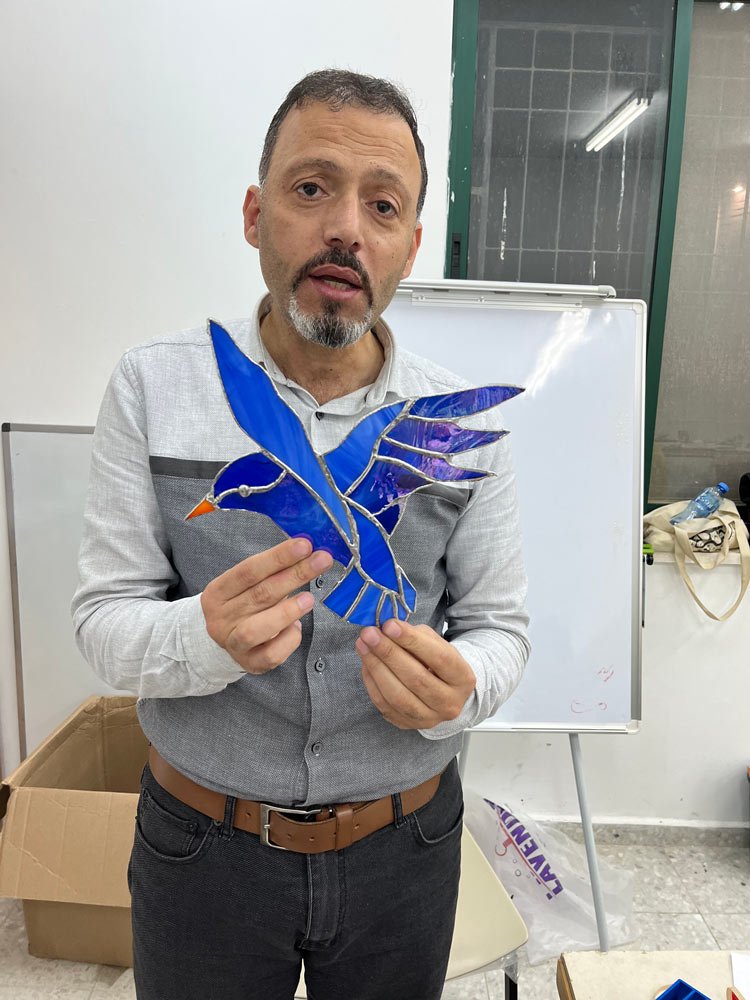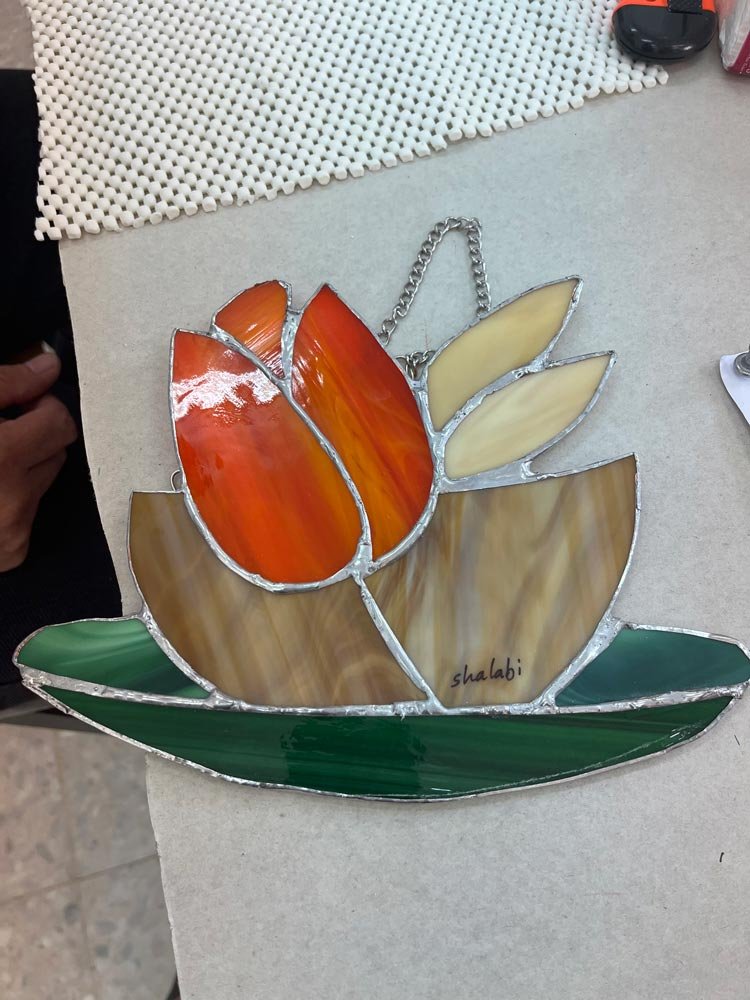by Kosovare Grebe
At the Muna and Basem Hishmeh Foundation, we spend most of our time making and holding space for so many others, that when one of our own gets a moment to shine, it’s very special. Not too long ago, between May and October of 2022, our co-founder, Muna Hishmeh, was asked to lead a workshop teaching stained glass after visiting the Visual Art Forum on one of her trips to Palestine. For those that don’t know, Muna is an experienced stained glass artist and has been commissioned by friends and family for years to create various pieces that adorn all of our homes and even some community centers around the world. To have a piece by Muna is to have a special treasure made with love, so it was no surprise that she was asked about this endeavor.
I got to take off my granddaughter hat and put on my journalist hat for this one, as I was able to interview my grandmother on her experience teaching these classes and where her passion for stained glass came from.
Kosovare: Was this part of a series of workshops with different leaders or was it just you teaching the workshop?
Muna: No, it was just me. When I was visiting the Visual Art Forum, the Art Forum has art classes for children after school and on weekends. All different kinds of arts and all mediums. So when I was there in May, they found out I do stained glass and asked me if I would do a workshop to teach stained glass in October when I returned and I said yes. Then we checked out to see what the availability of supplies and tools and such was, it didn't seem like too much of it existed [in the area] so I said I will put some things together and ship them. The only thing I was not able to ship was glass and flux. I was told that there was a supply of glass in Jerusalem from a Palestinian artist who paints on glass, but I needed the glass that’s already colored and he had that.
So my box arrived and we arrived in October. They sent out notices that I was going to have this workshop and 10 adults signed up. 8 women and 2 men. I was able to go to Jerusalem and get the glass and the flux and proceeded to do the workshop. They had the space set up for me. Unfortunately not all 10 people could come at the same time because some were coming from Jerusalem and they had issues in coming over. So one day they could come and the next they couldn’t. The workshop lasted almost 2 weeks and I gave them a project to do that wasn’t very difficult for starters and some did 2 projects. They all wanted to continue but unfortunately we ran out of flux and we were not able to get it locally. They were all very excited about doing the workshop, not realizing they could actually cut glass and put it back together again. One of the people that took the course is a professor at a local college, some of the students there are special needs. They teach them a skill or a craft for them to continue after they finish their schooling. This professor specializes in Arabic calligraphy, so at the end of the sessions as I was saying goodbye to everyone, he, they all, gave me this piece of calligraphy that he wrote. It’s a quote from the famous Palestinian poet Mahmoud Darwish “The butterfly does not leave its imprint but the butterfly will leave its impression.” And that’s it, they said they were going to continue possibly doing more stained glass if they were able to get the flux.
The butterfly does not leave its imprint but the butterfly will leave its impression.
K: Did you have any opportunities like this growing up? Any art workshops, anything like that?
M: No. My father was a factory worker, my mother was a seamstress, there was no extra money for the arts so to speak other than what I learned in school.
K: When did you discover stained glass as an art medium?
M: When we first moved to New Jersey, I had met a stained glass artist in Atlanta and commissioned him to do 2 windows for me for our house. I told him what design I wanted and I approved the design when he finished making it, and I told him what colors I wanted and he proceeded to make the 2 panels. When they were done he shipped them to me, unfortunately when I opened the crate, everything was broken into tiny little pieces. He was a stained glass artist but he didn’t know how to pack! So I put it on hold, kept the pattern, and then lo and behold I found 2 ladies in a local town near my town that would give stained glass classes. So I took it and loved it. My father built me a workshop in the basement and thats when it all started and I continued to do it. Once you take the lessons and you learn the procedure, it’s not necessary to continue taking lessons. So I kept doing it, I eventually made the 2 panels myself and now I do it for fun I do it for friends and family members.
K: What do you think connected you to it?
M: I liked the way it looked. I didn’t care too much for the heavy duty leaded glass other than it was very pretty, but when I found out about this one it’s called the Tiffany method, and I just liked the way it looked. I used to do quilting and basically I compare them to be the same. When you want to do a quilt, you make a design, you pick out the fabric you wanna use, then you cut up the fabric into pieces then you sew them back together again. Well the stained glass is similar, you make out your design/pattern, you pick out the glass you want to use, you cut up the glass into small pieces then you weld it back together. I enjoy it a lot more than the quilting!
K: What was it like to be asked to teach the workshop?
M: It was very nice, very exciting. I was happy, I’m always happy to teach whatever I know to anybody so I was happy to do it.
K: Do you consider yourself part of each piece you create? Like there is a piece of you in all of your artwork?
M: Well, only maybe in the colors I choose, and I like the abstract designs. I guess my surroundings are very abstract.
K: Do you think it’s important for the artist to take themselves out of the equation and to let the art speak for itself?
M: Speaking for me, since I never had art lessons, I’m not very good at drawing things. So if I’m going to have a tree in my design, I Google a tree, and Google sends me a print and I can draw it from the print. But for me to freehand draw it, I cannot. So for me, the abstract comes a little easier because I can do curves and waves and then put colors together. So is it me in the design? I guess to some people it might be. I guess it could be. But thats not the intent I don’t think. It’s whatever moves me that day.
K: What was your most memorable moment from your experience leading the workshop?
M: The camaraderie of the people I met for the first time and hearing a little bit of their stories and them asking me questions and that they were really interested in learning and very excited in learning it.
K: Do you think the whole point of art is to bring people together?
M: I think thats one aspect of it. Art is really for people to know whats going on in the world, what drives people, what makes them do what they do in the form of art they use. So it does bring people together but it’s not the sole meaning of it I guess.
K: You make so much art for family and friends, do you have a favorite piece that you’ve made? Or one that spoke to you more than others?
M: I like the one with the Oud, the one that I gifted to the Edward Said Conservatory. And that one, one of my friends helped me draw that one, Gail. The last piece I finish is usually my favorite so I guess it’s hard to say which one for sure.
K: Are you aware that your existence has brought so many people a joy that cannot be replaced?
M: No! Well I hope I bring joy to people! I love people! Most of all my favorite are my 6 grandchildren.
K: Was there a “you” in your life that you model your own life after?
M: I don’t think one particular person. Mother, grandmother, mother in law, great grandmother.
Journalist hat off for a moment, it makes my heart proud to know that a woman so instrumental in my own upbringing was made by all the women in her life before her. It really shows how when we build each other up, we have the power to create wonderful people who really give something to this world. Women have always been at the centers of community building and sharing knowledge for generations, and knowing that the woman I look up to in every way stays close to that mold shows me how much knowledge has been passed down to me without my even knowing. There’s a real sense of connection to the women that came before me that I realized in that instance interviewing my grandmother. To know that she is a product of all the women in her life, and that I am a product of all the women in my life, we are all connected throughout generations without even ever having met. What a beautiful power we get to hold.
Okay, journalist hat back on! As mentioned in the interview, one student, Mohammad Shalabi, gave a piece of his own artwork in the form of Arabic Calligraphy as a thank you to Muna for teaching the workshop.
Muna Hishmeh, The Artist
Because you plant roses … and wipe away tears … and draw a smile,
Then you are an angel in the form of a human being
The few days and moments that brought us together
are some of our most beautiful days.
May you stay loyal to your family
And true to your national roots
May you always be able to give
And may you always have good health and happiness
And your beautiful smile
Your admirers
Visual Arts Forum Family
Stained Glass Workshop
Ramallah, Palestine
25 October 2022
A huge takeaway from this interview was just how important new experiences are, no matter where you are in life. You could think you’ve aged out of trying something new but you could be limiting yourself of a talent you were always meant to give to the world. You could be forced to stay in your hometown by outside forces, but if you give up, you could be missing out on learning a skill that could change your life. Basically, each person involved in this workshop had no idea what they were getting themselves into when they started their stained glass journey. Muna thought she was just getting 2 new windows. Instead she opened a door full of possibilities.
"The Dream I Saw"
In partnership and support of TAAWON Association and Arab Fund for Economic & Social Development and Muna & Basem Hishmeh Foundation, Al Kamandjâti Association releases its new artistic production:
A song entitled: “The Dreams I Saw”.
Inception and composition: Iyad Staiti.
Lyrics: Dr Ziad Sawalmeh.
Filming, editing and directing: Madleine Shaban.
Performance: Students from all the centers of Al Kamandjâti Association.
“The Dream I Saw” is a song that tries to make an “aesthetic documentation” of the dreams of the Palestinian children who look forward to bypassing the walls and barriers and who hope as well, that someday, they will finish by getting rid of these obstacles. Metaphorically, the song uses the symbol of a “butterfly” in order to depict children yearning for the “Light”.
Children try to record and document the butterfly’s “Unseen Trace” declaring, thus, the decline of the Era when butterflies, birds and hopes were daily shattered amidst a deep silence.
The Dream I Saw
1-
Today, dreaming,
I saw butterflies
Swirling, hovering
Flapping, fluttering,
Fearless of walls
And barriers,
I wish I could imitate
Their flight,
So that
I could
head
Towards
Light.
2-
O! Tiny creatures,
Though I’m still young
I do dream big,
I do dream large.
With a tiny paintbrush,
A colourful book,
filled with melodies,
I will go out
Fluttering
throughout
All countries.
3-
Someday,
I will own wings
That fly
Across the sky,
Despite the fences
And the anguish
Of permissions,
Despite the thorns
-Even if they look
Numerous-,
Despite the walls
That may seem
Enormous,
Someday,
-even if blurred
Faraway-
They will -surely- be
“Gone with the wind”.
4-
The dream gets bigger
So does the child.
He will raise his hope
Through his sweat
And perseverance.
And he will tell
His story,
His rosy dream
About his gorgeous homeland
About his ever-verdant love.
Roses and birds will flock
Together, fearless….
Land, then, will burst into,
A multitude of colours…
Meet the New Board of Directors
Below is an article written by our granddaughter, Kosovare Ibrahimaj, responding to my question of how does it feel to join the board. The article speaks for itself and certainly makes Muna and I very proud of our grandchildren.
Basem Hishmeh
As the newest generation to be brought into the Muna and Basem Hishmeh Foundation, we recognize that there is a responsibility that comes with our new titles. My cousins, Blake (24) and Brady (22) Hishmeh, my brother, Nimon lbrahimaj (25), and I, Kosovare lbrahimaj (23), have had the chance to watch our grandparents bring joy to children's lives through their foundation, which brings music, dance, and art to the children of Palestine and underprivileged children throughout the US.
Our family wouldn't exist had our grandparents not been helped to come to America, and that alone has given us a different perspective on life. We were born with the knowledge that we are only here because of the goodness of others, and to truly honor the help we were given, we now have this goodness to pass along.
I was tasked with writing this article as one of my first introductions to my family's work. "How does it feel to be on the board of directors?" was the subject of the email sent from my grandfather. To say I was nervous to write this is an understatement. It all boiled down to this: What is the best way to introduce us that shows we are ready for our new roles? I turned to my cousins and brothers to see what they thought about it all.
To Blake, it strengthens his pride in our Palestinian ancestry. "I might have blonde hair and light skin, but I'm Palestinian and no one can take that away from me. We were brought up Palestinian, we ate Arabic food, we grew up in an Arabic household, and now we get to give back to our community and continue to contribute the way our grandparents taught us."
Brady shared this sentiment, adding that he is "incredibly proud to be a part of this foundation because of the sense of purpose it instills within us. Being able to give back to a community so rich in culture and strong at heart, along with the amazing talents of the children lends credence to a better and brighter future." He is "honored, and humbled, to be able to participate."
Pride is a strong driving force in our family, as Nimon's excitement stems from being "proud to be a part of something our grandparents started. Getting to learn about our heritage from people who have given back to their community is inspiring" and he "hopes to live up to their example."
Then there's how I feel about my new role. Simple answer, it feels pretty darn great! Like my cousins and brother, I also share their pride in our grandparents and our heritage. I now have more opportunities to bring the goodness given to our family into the lives of others. I've been waiting for this time to come where I can really be involved in making the world a better place, and what better first step than this one!
As for the not so simple answer, it feels ... layered. On one hand, yes, it is simply wonderful to be part of such an amazing organization. On another hand, it feels almost bittersweet. It means that there is still a need for charity work to be present in this world. It means that Palestinian children are still struggling. It means the occupation of Palestine is still alive and well. It means that injustice and human rights violations are still happening.
So ... where does that leave me?
It leaves me feeling motivated. It leaves our family feeling motivated. No occupation, no apartheid, no social or human injustice will stand in the way of my family. My grandparents created this foundation not just to bring music and art to children, but to give them more purpose in life. To open doors that were previously closed or nonexistent. And now we get to be part of that legacy.
While the four of us- Blake, Brady, Nimon, and myself- are becoming directors of the foundation, there's two more that aren't far behind us. My cousin Hayden Hishmeh (19) and my younger brother llir lbrahimaj (19) are well on their way to making an impact in the world, and their time to shine with the foundation will soon follow. Although not on the board of directors yet, the excitement they share for their futures with us is not lost. "Being able to actively participate in, and having an actual role in, the foundation" is just one of the many reasons llir will be happy about becoming a director. Hayden shares this enthusiasm as well, stating "the arts have the ability to change a person's reality. As a board member I'll have even more of an opportunity to help improve these children’s' lives."
With these new titles comes new responsibilities. The responsibility to uphold the integrity of the foundation. The responsibility to help this foundation age and grow long beyond our time with it. And the responsibility to use our privilege as a tool to keep Palestinian and American children at the center of the discussion because not so long ago, our grandparents were those children. They created this foundation knowing what life is like in the children’s' shoes. They raised us to know how incredibly lucky we are that we only know of these harsh circumstances through stories and not experiences. They raised us to understand the importance of giving back to the community that gave them a chance at freedom. They taught us that with knowledge comes the responsibility to spread that knowledge, and in spreading that knowledge comes progress, and from that progress real change can happen. That is their legacy. That is what the bones of this foundation are made from. And we intend to keep it that way.
So, Sido, how does it feel to be on the board of directors? It feels like it's about time.
Organization Creatively Adapts to COVID-19 Restrictions
Throughout this developing global situation many organizations and schools have had their services restricted and hindered. However, the strength of organizations to shift and pivot their resources into managing under these new circumstances speaks to the success, passion, and drive of these organizations. The Edward Said National Conservatory of Music is one of these fantastic organizations thriving under new conditions. Here is an update on their ongoing activities.
Performing in the Age of COVID-19
The ever developing global situation with COVID-19 continues to affect each and every one of us and our communities around the world. In times like these, the arts and music provide a respite from the chaos around us. The music students of Al Kamandjati have not let this virus prevent them from furthering their studies, however, and performed this piece from their respective homes, and compiled the parts into an incredible performance of Farid Al-Atrash’s Ya Zahratan fi Khayaleh, dedicated as a gift and love letter to the Muna and Basem Hishmeh Foundation.
Al Kamandjâti 2018-2019 Annual Narrative Report
Al Kamandjâti exists to make music accessible to the entire Palestinian community and to teach music to Palestinian children and strengthen their appreciation of Palestinian culture and identity.
The 2018-2019 programs provide music education programs and lessons to children in refugee camps and UNRWA schools and opportunities to perform in several concerts, including the end-of-year student concert.
Watch other 2018-2019 concert highlights:
Christmas 2018 concert:
https://www.facebook.com/watch/?v=2035178733227885
Jalazon students’ concert:
https://www.facebook.com/alkamandjati/videos/473795766488567/
Ramallah Orchestra:
https://youtu.be/OjgCrdAvqu8
This year the association also organized a 5-day summer music camp with international guest musicians to create new musical experiences for students. Download the full report to read more, including student testimonials, individual student progress and success stories.
Testimonial Videos: ACCESS Arab Americans of The Year Award
Watch video testimonials from esteemed education and community leaders as they honor Muna and Basem Hishmeh, recipients of the 2019 ACCESS 48th Arab Americans of The Year Award. Read more about the annual ACCESS event and this year’s theme From the Neighborhood to the Nation.
VIDEO: Arab Americans of the Year: Basem and Muna Hishmeh
Every year since it's inception, ACCESS (Arab Community Center for Economic and Social Services) presents the prestigious Arab American of the Year award to distinguished international advocates and philanthropists. This year the organization honored Basem and Muna Hishmeh at its 48th Annual Dinner on Thursday, March 28, 2019.
"Basem and Muna’s extraordinary commitment to numerous worthy causes has helped them uplift the voices of countless individuals and communities in various parts of the world. Their unwavering support of various impactful causes embodies the spirit of compassion that is at the heart of ACCESS’ efforts to empower our communities."
Watch ACCESS’s video to learn more about the Hishmeh’s unwavering commitment and support of initiatives that promote the cultural and artistic expression of American and Palestinian youth.
ACCESS 2019 Arab Americans Of The Year Awardees
Distinguished international advocates and philanthropists, Basem and Muna Hishmeh, learned the value of giving early in life. Both Palestinian refugees who came to the United States with their families as teens in the 1950s, the generosity and compassion of their sponsors indelibly paved their path towards a lifetime of community empowerment.
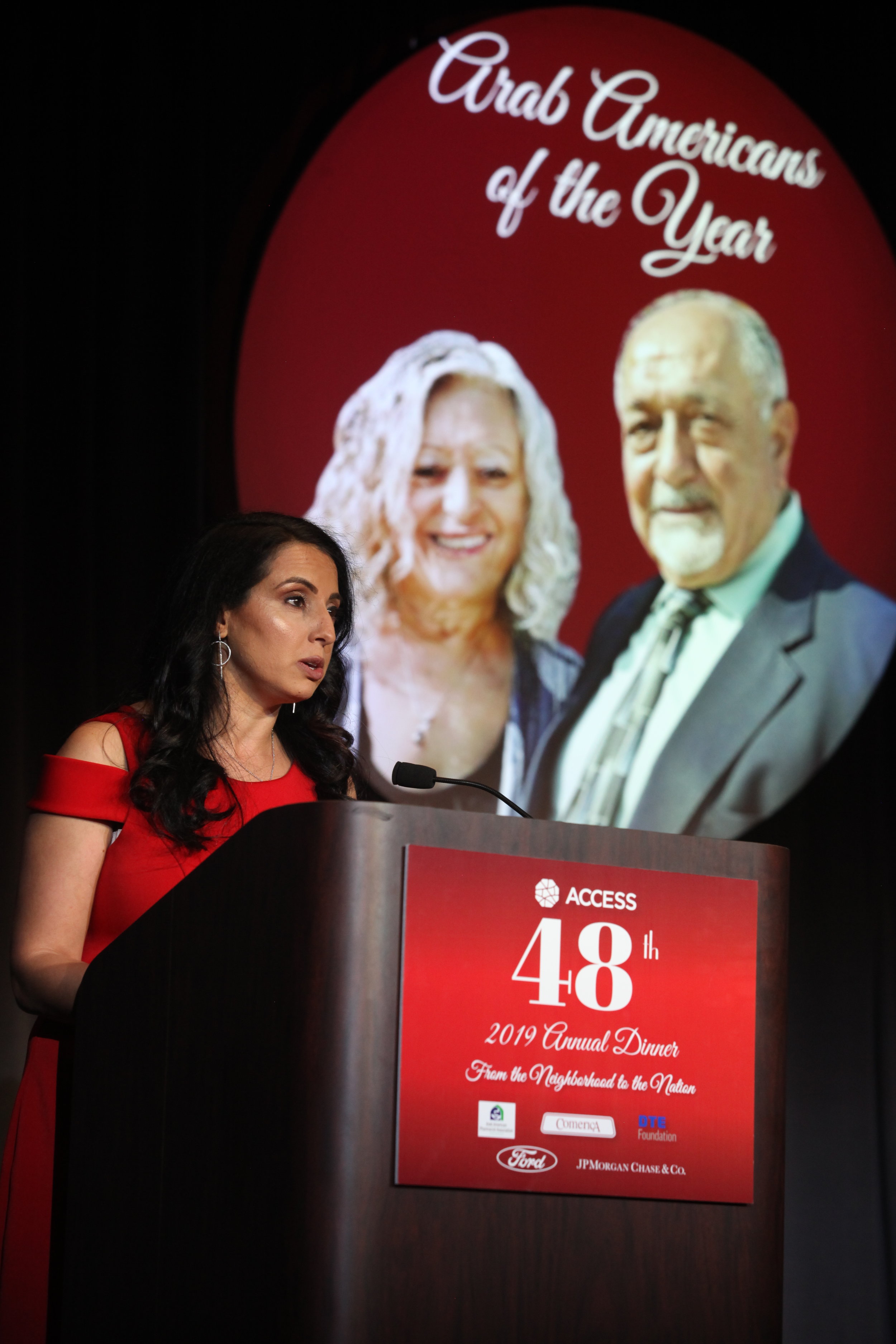
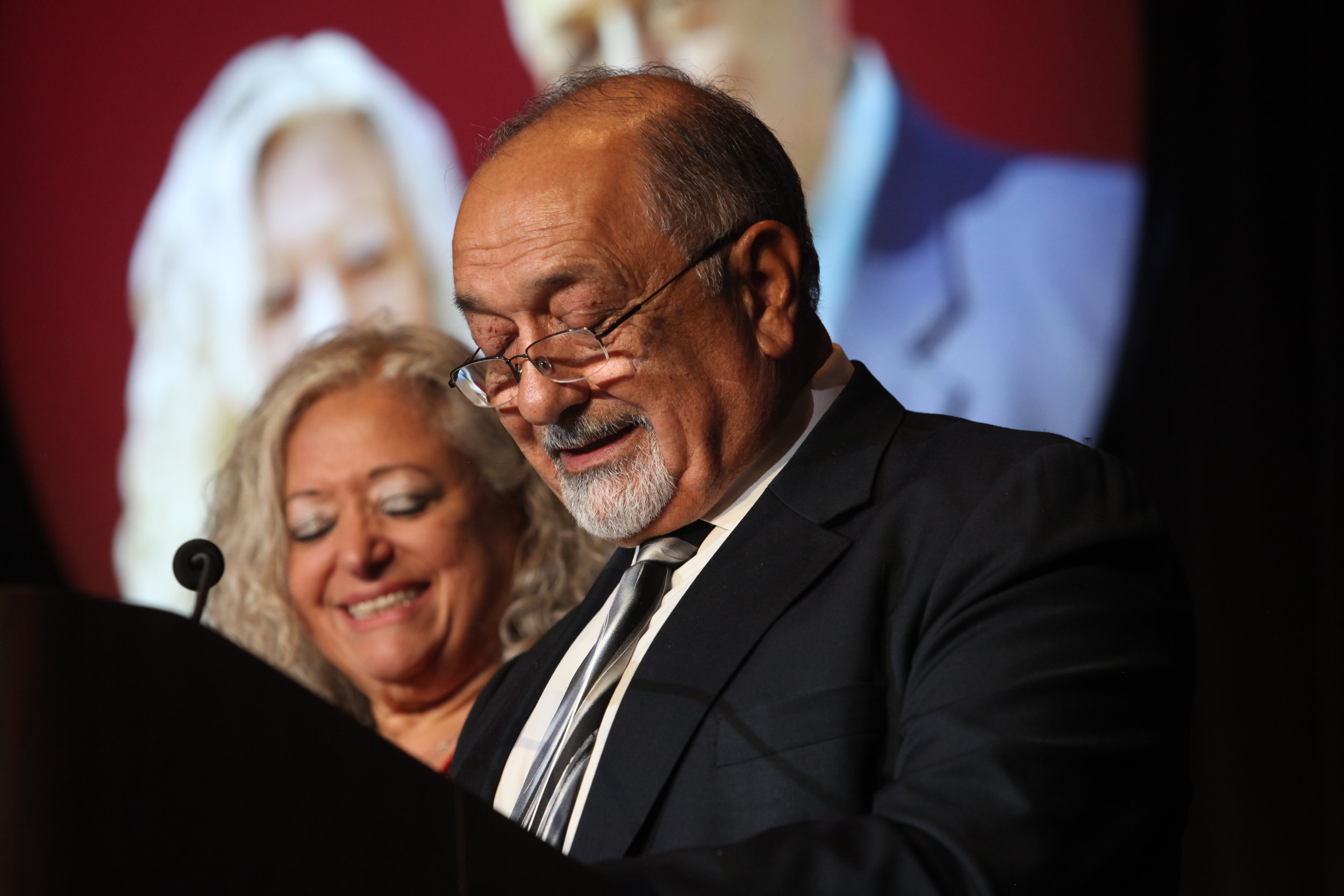
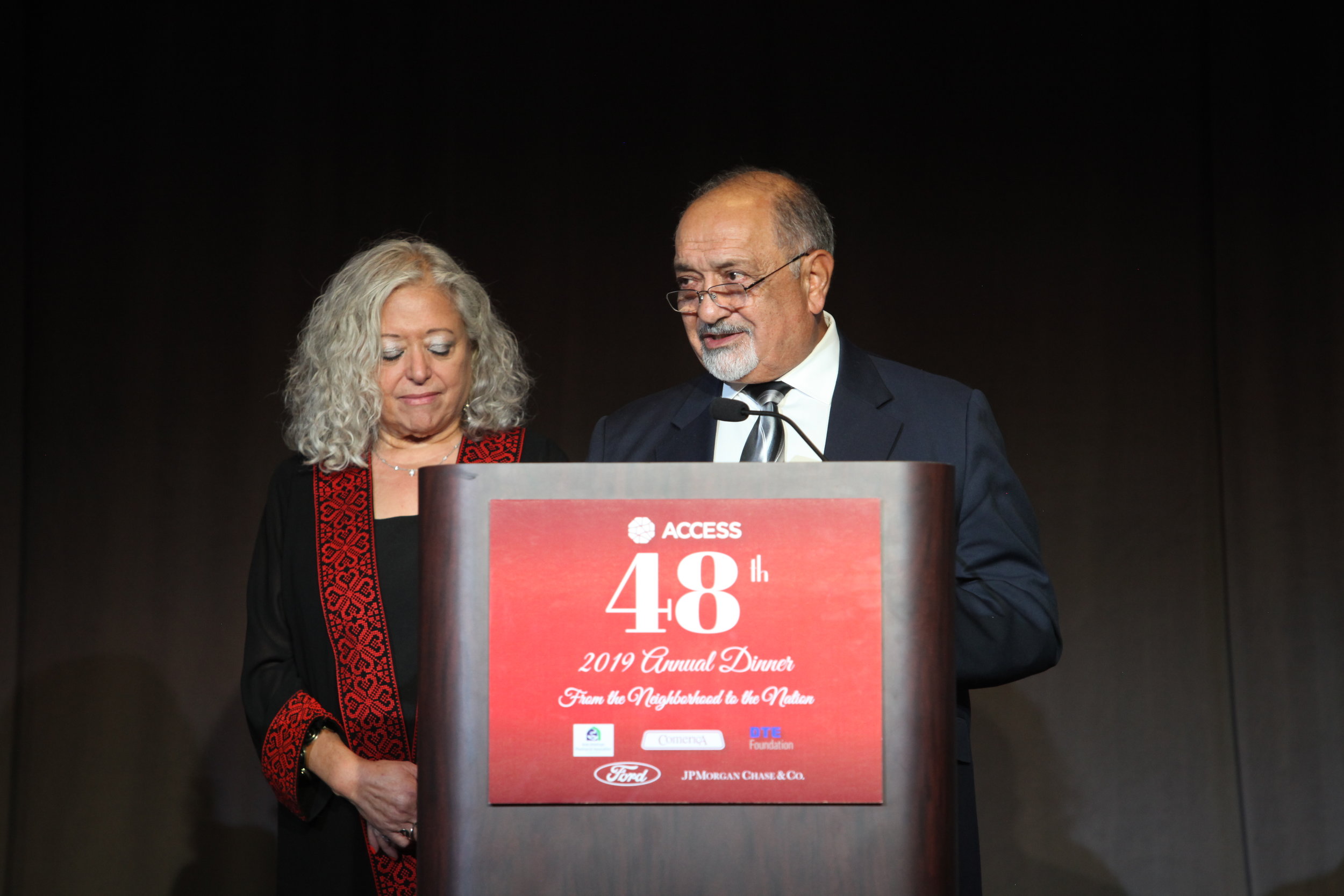

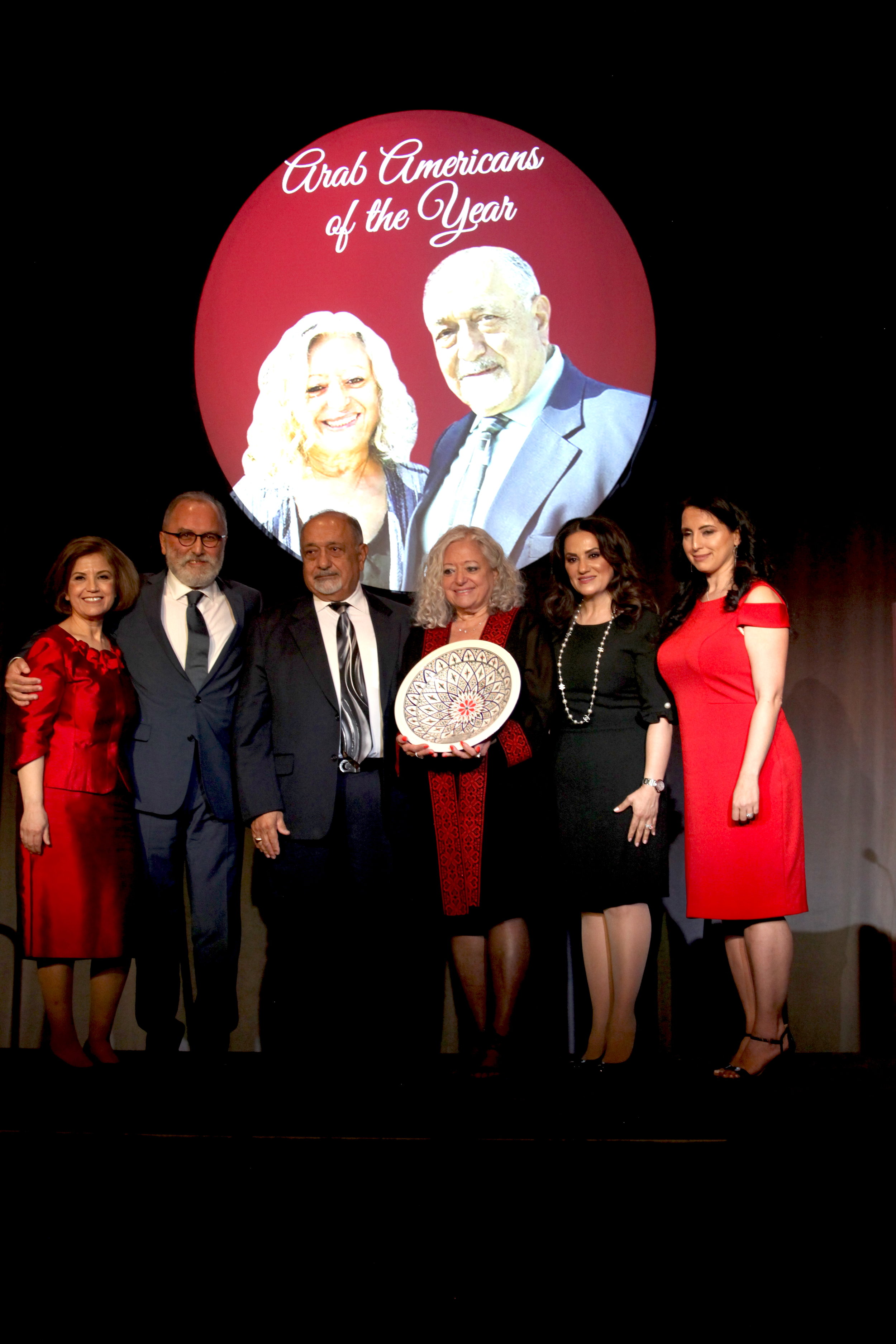
Basem earned his engineering degree from Case Institute of Technology and MBA from the prestigious Case Western Reserve University, propelling him into an impressive and extremely successful international engineering and business career.
After decades of rewarding career ventures, Muna and Basem chose to reciprocate the empathy and humanity they were graced with as refugee youth. In 2007, they founded The Muna and Basem Hishmeh Foundation to provide educational and cultural arts opportunities to under-served youth in the United States and Palestine. Muna guided the foundation’s vision in the language that empowered her the most as a child, the language of art.
The foundation’s many beneficiaries include inspiring youth programs at Cleveland Orchestra, New York Philharmonic, National Dance Institute, Arab American National Museum (AANM), Center for Arab American Philanthropy (CAAP) and New York’s Roundabout Theatre Company. In Palestine, the foundation supports extraordinary arts and music programs at First Ramallah Group Dance School, Edward Said Conservatory of Music, Al Kamandjati and Rawdat El Zuhur in Jerusalem. Additionally, the Hishmehs extend their generous support to ensure there are safe spaces for children to play at Al Bayyara playgrounds and provide critical support to medical organizations including The Cleft Society, The Dialysis Center and The Diabetes Center which has changed the lives of countless residents.
Muna and Basem reside in both New Jersey and Florida and have two children and six grandchildren that assist them with the foundation’s operations.





